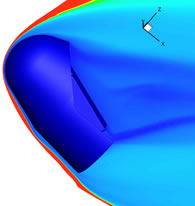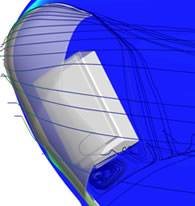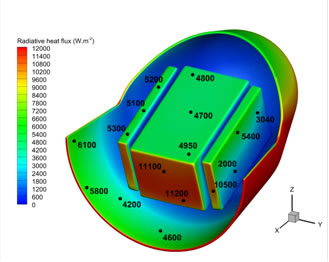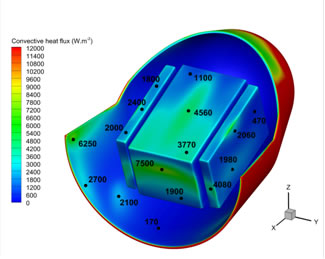End of the European project AEROFAST relating to Martian aerocapture. Thanks to its expertise in aerothermodynamics, ONERA has selected a design by numerical simulation that will allow orbiters to be economically placed in orbit around Mars.
 |
 |
| Flow around the transporter during aerocapture. Mach number (from blue-0 to red-29). | Current lines behind the open transporter. Satellite in the hold. |
The purpose of the European project Aerofast, leaded by EADS Astrium Space Transportation, as part of preparation for future manned Martian missions, was the design of an inter-planetary transporter vehicle capable of placing a satellite in Martian orbit after atmospheric braking in a single pass.
The necessary slowing of the vehicle in order to go from cruising to orbiting involves a speed reduction of around 2 km/s. Aerocapture, that is to say, atmospheric braking by aerodynamic friction, allows a 30 to 50% gain in propellant mass compared to when only using the engines, but it also means a descent to an altitude of 40km before the climb. This gain in mass is an advantage that cannot be overlooked for a heavy mission, such as a manned mission... which needs to return.
Thanks to its unique 3D Navier-Stokes simulations, together with the radiation of the very high temperature Martian gas, ONERA has been able to estimate the heating conditions for this manoeuver in a carbonic gas atmosphere, characteristic of the planet Mars. The flow infrared radiation in the immediate vicinity of a transporter heats its wall, as well as the orbiter on board under its protection, which is more critical.
These simulations lead to a decision in favour of a blunt biconic geometry for the transport vehicle, rather than an Apollo capsule type geometry (another possible candidate for aerocapture). However, the heating predictions for the chosen configuration means that the satellite needs to be carried in a closed transporter, rather than protecting it in the rear of an open transporter, which would make it easier to drop when the time comes to do so.
Always at the leading edge in regard to aerodynamics and aeronautical energetics, ONERA’s expertise also extends to Martian aerothermodynamics.

Radiative heating (W/m2) in the rear of an open transporter with a satellite in the hold – Mach 29

Convective heating (W/m2) in the rear of an open transporter
with a satellite in the hold – Mach 29




